High-Intensity Laser-Driven Oxygen Source from CW Laser-Heated Titanium Tape Targets
Abstract
1. Introduction
2. Hydrocarbon Removal by CW Laser Irradiation of Titanium Tape
3. Demonstration Experiment of Intense Laser-Driven Oxygen Source
4. Discussion
5. Conclusions
Author Contributions
Funding
Acknowledgments
Conflicts of Interest
References
- Danson, C.N.; Haefner, C.; Bromage, J.; Butcher, T.; Chanteloup, J.-C.F.; Chowdhury, E.A.; Galvanauskas, A.; Gizzi, L.A.; Hein, J.; Hillier, D.I.; et al. Petawatt and exawatt class lasers worldwide. High-Power Laser Sci. Eng. 2019, 7, e54. [Google Scholar] [CrossRef]
- Di Piazza, A.; Müller, C.; Hatsagortsyan, K.Z.; Keitel, C.H. Extremely high-intensity laser interactions with fundamental quantum systems. Rev. Mod. Phys. 2012, 84, 1177. [Google Scholar] [CrossRef]
- Macchi, A.; Borghesi, M.; Passoni, M. Ion acceleration by super intense laser-plasma interaction. Rev. Mod. Phys. 2013, 85, 751. [Google Scholar] [CrossRef]
- Daido, H.; Nishiuchi, M.; Pirozhkov, A.S. Review of laser-driven ion sources and their applications. Rep. Prog. Phys. 2012, 75, 056401. [Google Scholar] [CrossRef] [PubMed]
- Malka, V.; Faure, J.; Gauduel, Y.A.; Lefebvre, E.; Rousse, A.; Phuoc, K.T. Principles and applications of compact laser–plasma accelerators. Nat. Phys. 2008, 4, 447. [Google Scholar] [CrossRef]
- Esarey, E.; Schroeder, C.B.; Leemans, W.P. Physics of laser-driven plasma-based electron accelerators. Rev. Mod. Phys. 2009, 81, 1229. [Google Scholar] [CrossRef]
- Pirozhkov, A.S.; Esirkepov, T.Z.; Pikuz, T.A.; Faenov, A.Y.; Ogura, K.; Hayashi, Y.; Kotaki, H.; Ragozin, E.N.; Neely, D.; Kiriyama, H.; et al. Burst intensification by singularity emitting radiation in multi-stream flows. Sci. Rep. 2017, 7, 17968. [Google Scholar] [CrossRef]
- Soloviev, A.; Burdonov, K.; Chen, S.N.; Eremeev, A.; Korzhimanov, A.; Pokrovskiy, G.V.; Pikuz, T.A.; Revet, G.; Sladkov, A.; Ginzburg, V.; et al. Experimental evidence for short-pulse laser heating of solid-density target to high bulk temperatures. Sci. Rep. 2017, 7, 12144. [Google Scholar] [CrossRef]
- Mohamad, O.; Sishc, B.J.; Saha, J.; Pompos, A.; Rahimi, A.; Story, M.D.; Davis, A.J.; Kim, D.W.N. Carbon Ion Radiotherapy: A Review of Clinical Experiences and Preclinical Research, with an Emphasis on DNA Damage/Repair. Cancer 2017, 9, 66. [Google Scholar] [CrossRef]
- Inaniwa, T.; Kanematsu, N.; Noda, K.; Kamada, T. Treatment planning of intensity modulated com- posite particle therapy with dose and linear energy transfer optimization. Phys. Med. Biol. 2017, 62, 5180. [Google Scholar] [CrossRef]
- Willingale, L.; Mangles, S.P.D.; Nilson, P.M.; Clarke, R.J.; Dangor, A.E.; Kaluza, M.C.; Karsch, S.; Lancaster, K.L.; Mori, W.B.; Najmudin, Z.; et al. Collimated Multi-MeV Ion Beams from High-Intensity Laser Interactions with Underdense Plasma. Phys. Rev. Lett. 2006, 96, 245002. [Google Scholar] [CrossRef] [PubMed]
- Palmer, C.A.J.; Dover, N.P.; Pogorelsky, I.; Babzien, M.; Dudnikova, G.I.; Ispiriyan, M.; Polyanskiy, M.N.; Schreiber, J.; Shkolnikov, P.; Yakimenko, V.; et al. Monoenergetic Proton Beams Accelerated by a Radiation Pressure Driven Shock. Phys. Rev. Lett. 2011, 106, 014801. [Google Scholar] [CrossRef] [PubMed]
- Chen, S.N.; Vranic, M.; Gangolf, T.; Boella, E.; Antici, P.; Bailly-Grandvaux, M.; Loiseau, P.; Pépin, H.; Revet, G.; Santos, J.J.; et al. Collimated protons accelerated from an overdense gas jet irradiated by a 1 μm wavelength high-intensity short-pulse laser. Sci. Rep. 2017, 7, 13505. [Google Scholar] [CrossRef] [PubMed]
- Krushelnick, K.; Clark, E.L.; Najmudin, Z.; Salvati, M.; Santala, M.I.K.; Tatarakis, M.; Dangor, A.E.; Malka, V.; Neely, D.; Allott, R.; et al. Multi-MeV Ion Production from High-Intensity Laser Interactions with Underdense Plasmas. Phys. Rev. Lett. 1999, 83, 737. [Google Scholar] [CrossRef]
- Wilks, S.C.; Langdon, A.B.; Cowan, T.E.; Roth, M.; Singh, M.; Hatchett, S.; Key, M.H.; Pennington, D.; MacKinnon, A.; Snavely, R.A. Energetic proton generation in ultra-intense laser–solid interactions. Phys. Plasmas 2001, 8, 542. [Google Scholar] [CrossRef]
- Cowan, T.E.; Fuchs, J.; Ruhl, H.; Kemp, A.; Audebert, P.; Roth, M.; Stephens, R.; Barton, I.; Blazevic, A.; Brambrink, E.; et al. Ultralow Emittance, Multi-MeV Proton Beams from a Laser Virtual-Cathode Plasma Accelerator. Phys. Rev. Lett. 2004, 92, 204801. [Google Scholar] [CrossRef]
- Fuchs, J.; Cowan, T.E.; Audebert, P.; Ruhl, H.; Gremillet, L.; Kemp, A.; Allen, M.; Blazevic, A.; Gauthier, J.-C.; Geissel, M.; et al. Spatial Uniformity of Laser-Accelerated Ultrahigh-Current MeV Electron Propagation in Metals and Insulators. Phys. Rev. Lett. 2003, 91, 255002. [Google Scholar] [CrossRef]
- Hegelich, M.; Karsch, S.; Pretzler, G.; Habs, D.; Witte, K.; Guenther, W.; Allen, M.; Blazevic, A.; Fuchs, J.; Gauthier, J.C.; et al. MeV Ion Jets from Short-Pulse-Laser Interaction with Thin Foils. Phys. Rev. Lett. 2002, 89, 085002. [Google Scholar] [CrossRef]
- Hegelich, B.M.; Albright, B.J.; Cobble, J.; Flippo, K.; Letzring, S.; Paffett, M.; Ruhl, H.; Schreiber, J.; Schulze, R.K.; Fernández, J.C. Laser acceleration of quasi-monoenergetic MeV ion beams. Nature 2006, 439, 441. [Google Scholar] [CrossRef]
- Allen, M.; Patel, P.K.; Mackinnon, A.; Price, D.; Wilks, S.; Morse, E. Direct Experimental Evidence of Back-Surface Ion Acceleration from Laser-Irradiated Gold Foils. Phys. Rev. Lett. 2004, 93, 265004. [Google Scholar] [CrossRef]
- Hoffmeister, G.; Bellei, C.; Harres, K.; Ivanov, D.; Kraus, D.; Pelka, A.; Rethfeld, B.; Schaumann, G.; Roth, M. Influence of fs-laser desorption on target normal sheath accelerated ions. Phys. Rev. Accel. Beams 2013, 16, 041304. [Google Scholar] [CrossRef]
- Sommer, P.; Metzkes-Ng, J.; Brack, F.-E.; Cowan, T.E.; Kraft, S.D.; Obst, L.; Rehwald, M.; Schlenvoigt, H.-P.; Schramm, U.; Zeil, K. Laser-ablation-based ion source characterization and manipulation for laser-driven ion acceleration. Plasma Phys. Control. Fusion 2018, 60, 054002. [Google Scholar] [CrossRef]
- Nishiuchi, M.; Dover, N.P.; Hata, M.; Sakaki, H.; Kondo, K.; Lowe, H.F.; Miyahara, T.; Kiriyama, H.; Koga, J.K.; Iwata, N.; et al. Dynamics of laser-driven heavy-ion acceleration clarified by ion charge states. Phys. Rev. Res. 2020, 2, 033081. [Google Scholar] [CrossRef]
- Jung, D.; Yin, L.; Gautier, D.C.; Wu, H.-C.; Letzring, S.; Dromey, B.; Shah, R.; Palaniyappan, S.; Shimada, T.; Johnson, R.P.; et al. Laser-driven 1 GeV carbon ions from preheated diamond targets in the break-out afterburner regime. Phys. Plasmas 2013, 20, 083103. [Google Scholar] [CrossRef]
- Safronov, K.V.; Gorokhov, S.A.; Flegentov, V.A.; Potapov, A.V.; Gavrilov, D.S.; Kakshin, A.G.; Loboda, E.A.; Vikhlyaev, D.A. Laser-driven ion acceleration from thin foils heated by CW laser. Phys. Plasmas 2018, 25, 103114. [Google Scholar] [CrossRef]
- Lindner, F.H.; McCary, E.; Jiao, X.; Ostermayr, T.M.; Roycroft, R.; Tiwari, G.; Hegelich, B.M.; Schreiber, J.; Thirolf, P.G. En-route to the fission–fusion reaction mechanism: A status update on laser-driven heavy ion acceleration. Plasma Phys. Control. Fusion 2019, 61, 055002. [Google Scholar] [CrossRef]
- Wang, G.; Li, J.; Lv, K.; Zhang, W.; Ding, X.; Yang, G.; Liu, X.; Jiang, X. Surface thermal oxidation on titanium implants to enhance osteogenic activity and in vivo osseointegration. Sci. Rep. 2016, 6, 31769. [Google Scholar] [CrossRef]
- Bradshow, F.J. The optical emissivity of Titanium and Zirconium. Proc. Phys. Soc. B 1950, 63, 573. [Google Scholar] [CrossRef]
- Tsuchiya, B.; Nagata, S.; Ohtsu, N.; Toh, K.; Shikama, T. Thermal desorption of hydrogen at the Titanium hydride-oxide interface. Mater. Trans. 2005, 46, 196. [Google Scholar] [CrossRef]
- Koch, D.; Manzhos, S. On the Charge State of Titanium in Titanium Dioxide. J. Phys. Chem. Lett. 2017, 8, 1593. [Google Scholar] [CrossRef]
- Kiriyama, H.; Pirozhkov, A.S.; Nishiuchi, M.; Fukuda, Y.; Ogura, K.; Sagisaka, A.; Miyasaka, Y.; Mori, M.; Sakaki, H.; Dover, N.P.; et al. High-contrast high-intensity repetitive petawatt laser. Opt. Lett. 2018, 43, 2595. [Google Scholar] [CrossRef] [PubMed]
- Pirozhkov, A.S.; Fukuda, Y.; Nishiuchi, M.; Kiriyama, H.; Sagisaka, A.; Ogura, K.; Mori, M.; Kishimoto, M.; Sakaki, H.; Dover, N.P.; et al. Approaching the diffraction-limited, bandwidth-limited Petawatt. Opt. Express 2017, 25, 20486–20501. [Google Scholar] [CrossRef] [PubMed]
- NIST Atomic Spectra Database Ionization Energies Form. Available online: https://physics.nist.gov/PhysRefData/ASD/ionEnergy.html (accessed on 1 September 2020).
- Dover, N.P.; Nishiuchi, M.; Sakaki, H.; Kondo, K.; Alkhimova, M.A.; Faenov, A.Y.; Hata, M.; Iwata, N.; Kiriyama, H.; Koga, J.K.; et al. Effect of small focus on electron heating and proton acceleration in ultrarelativistic laser-solid inter- actions. Phys. Rev. Lett. 2020, 124, 084802. [Google Scholar] [CrossRef] [PubMed]
- Allen, M.; Sentoku, Y.; Audebert, P.; Blazevic, A.; Cowan, T.; Fuchs, J.; Gauthier, J.C.; Geissel, M.; Hegelich, M.; Karsch, S.; et al. Proton spectra from ultraintense laser–plasma interaction with thin foils: Experiments, theory, and simulation. Phys. Plasmas 2003, 10, 3283. [Google Scholar] [CrossRef]
- Bychenkov, V.Y.; Novikov, V.N.; Batani, D.; Tikhonchuk, V.T.; Bochkarev, S.G. Ion acceleration in expanding multispecies plasmas. Phys. Plasmas 2004, 11, 3242. [Google Scholar] [CrossRef]
- Dollar, F.; Matsuoka, T.; Petrov, G.M.; Thomas, A.G.R.; Bulanov, S.S.; Chvykov, V.; Davis, J.; Kalinchenko, G.; McGuffey, C.; Willingale, L.; et al. Control of Energy Spread and Dark Current in Proton and Ion Beams Generated in High-Contrast Laser Solid Interactions. Phys. Rev. Lett. 2011, 107, 065003. [Google Scholar] [CrossRef]
- Dover, N.P.; Palmer, C.A.J.; Streeter, M.J.V.; Ahmed, H.; Albertazzi, B.; Borghesi, M.; Carroll, D.C.; Fuchs, J.; Heathcote, R.; Hilz, P.; et al. Buffered high charge spectrally-peaked proton beams in the relativistic-transparency regime. New J. Phys. 2016, 18, 013038. [Google Scholar] [CrossRef]
- Evertssona, J.; Bertrama, F.; Zhangc, F.; Rullika, L.; Mertea, L.R.; Shipilina, M.; Soldemoe, M.; Ahmadie, S.; Vinogradovd, N.; Carlàd, F.; et al. The thickenss of native oxides on aluminum alloys and single crystals. Appl. Surf. Sci. 2015, 349, 826. [Google Scholar] [CrossRef]
- Olsson, C.-O.A.; Landolt, D. Passive films on stainless steels-chemistry, structure and growth. Electrochim. Acta 2003, 48, 1093. [Google Scholar] [CrossRef]
- Ma, S.; Ning, X.; Fu, T.; Zhou, H.; Chen, K. Fabrication of Thick Silicon Nitride Substrate by Tape Casting. Key Eng. Mater. 2008, 368, 875. [Google Scholar] [CrossRef]
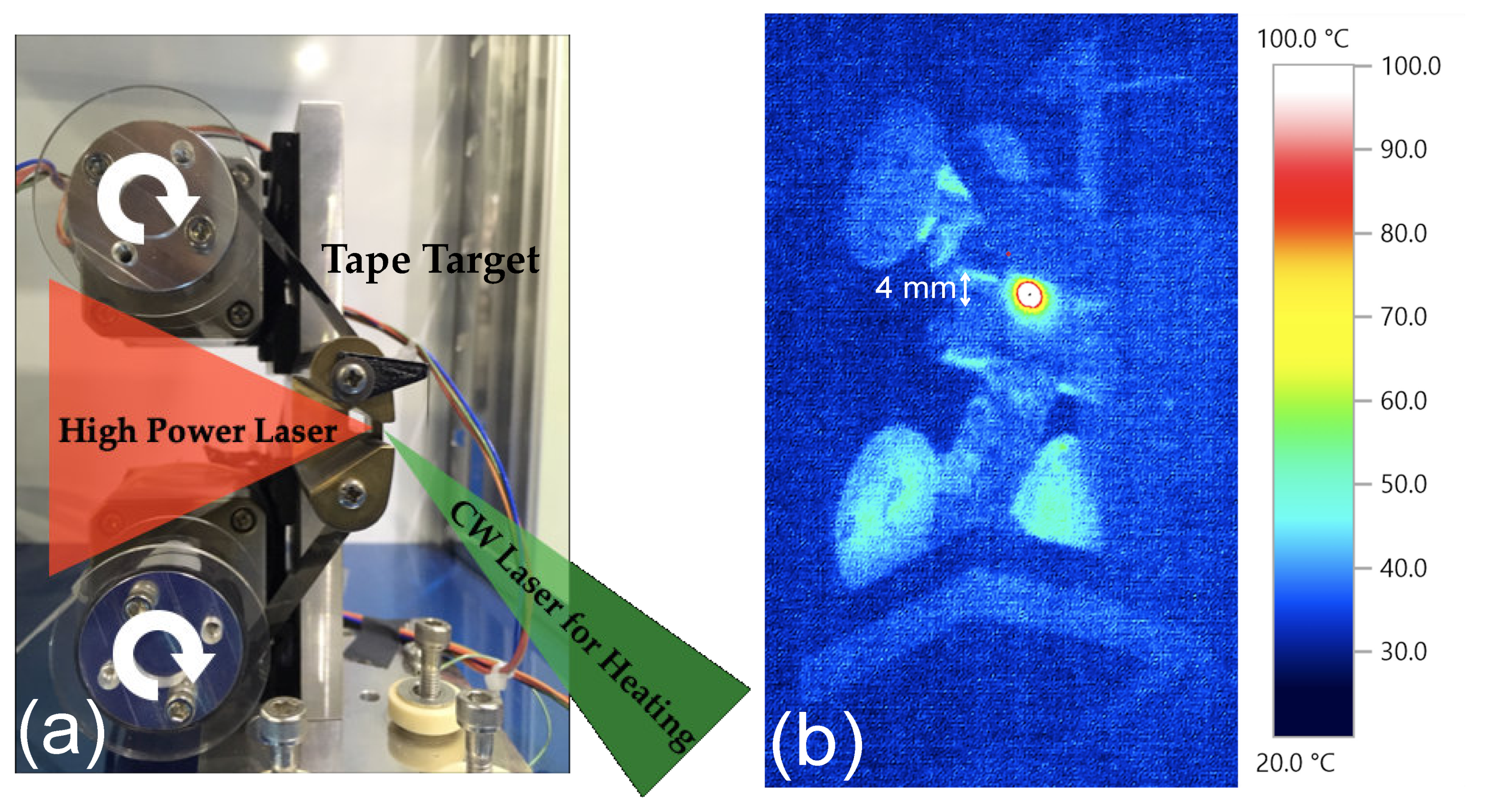
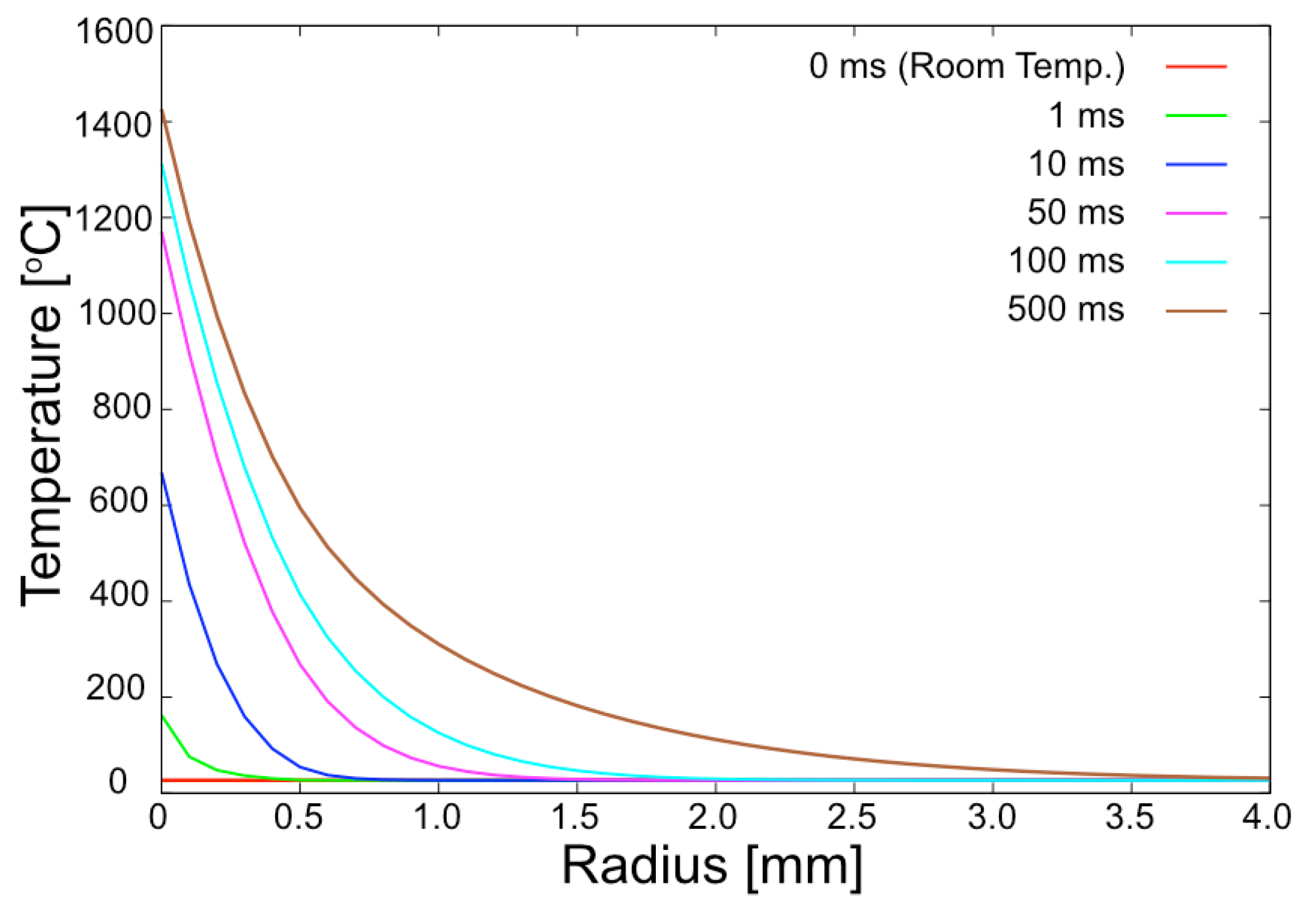
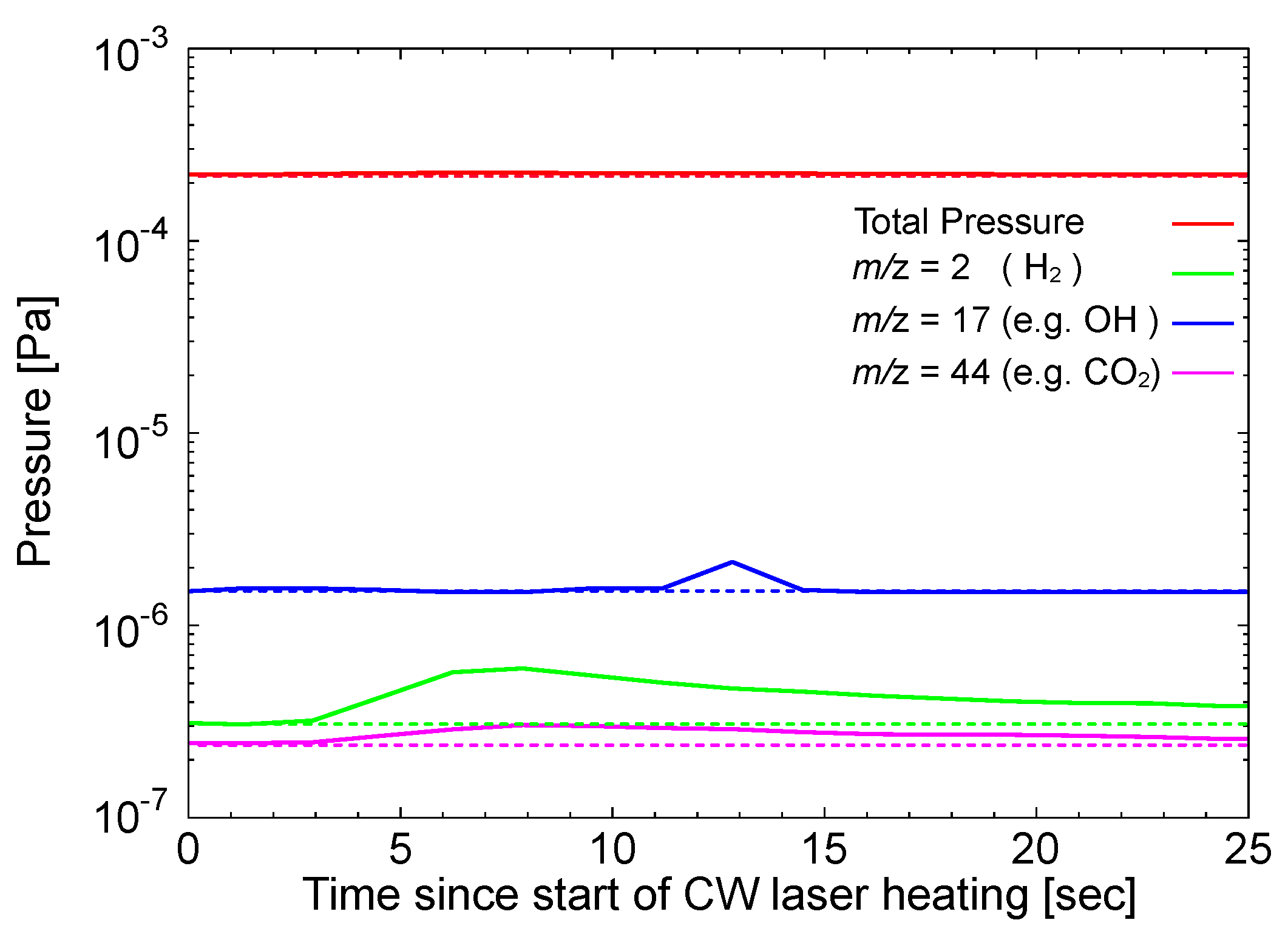
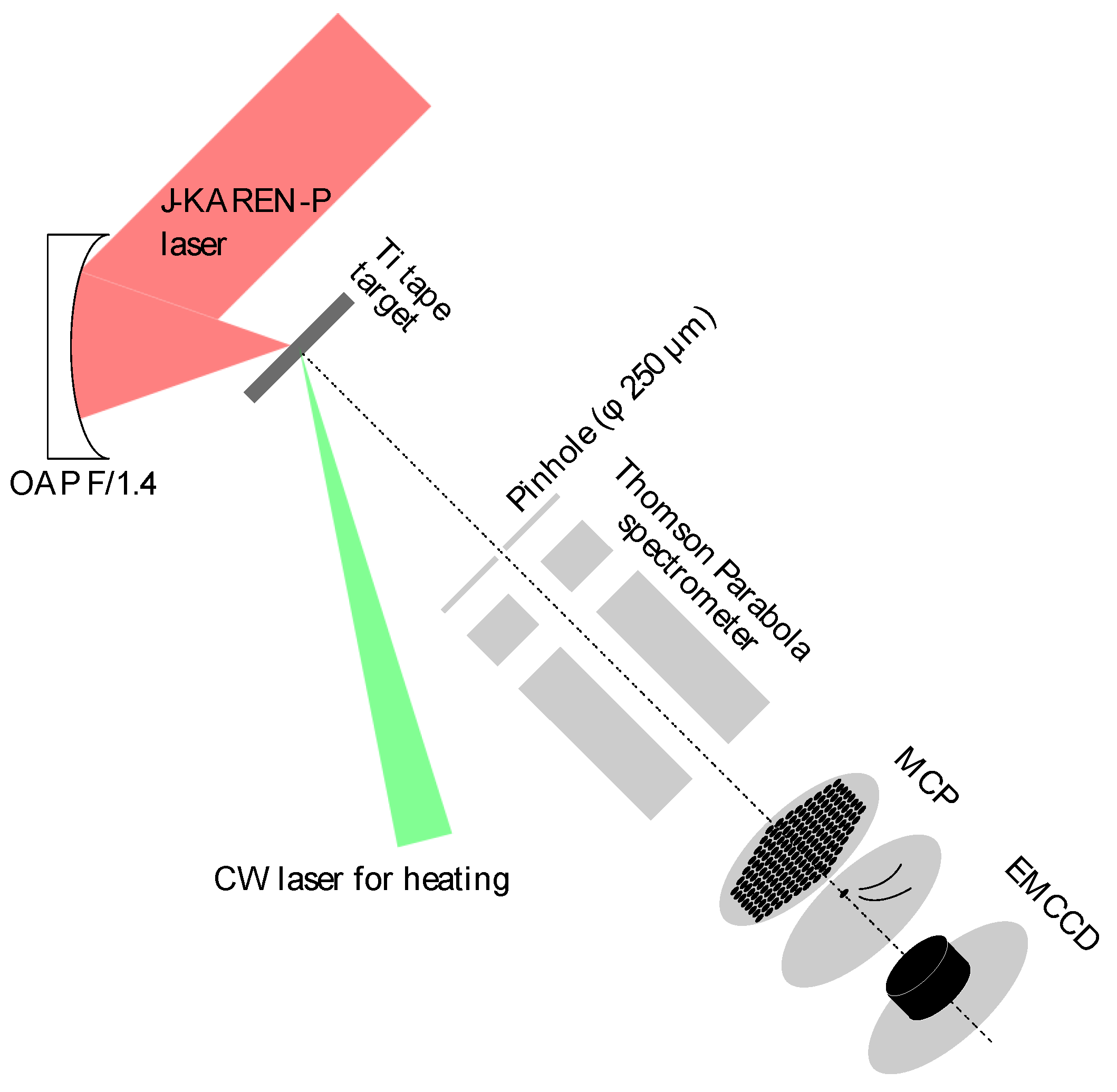
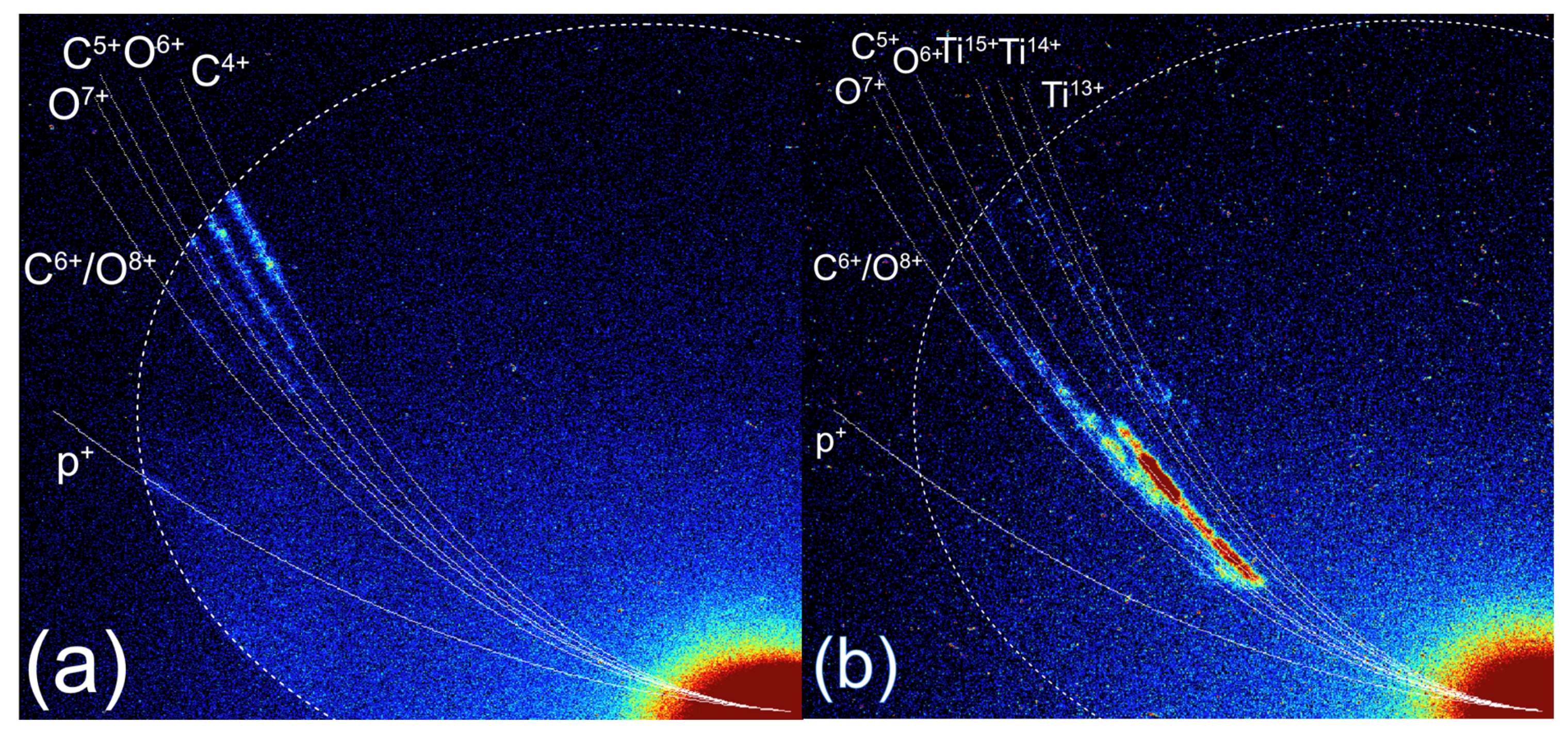
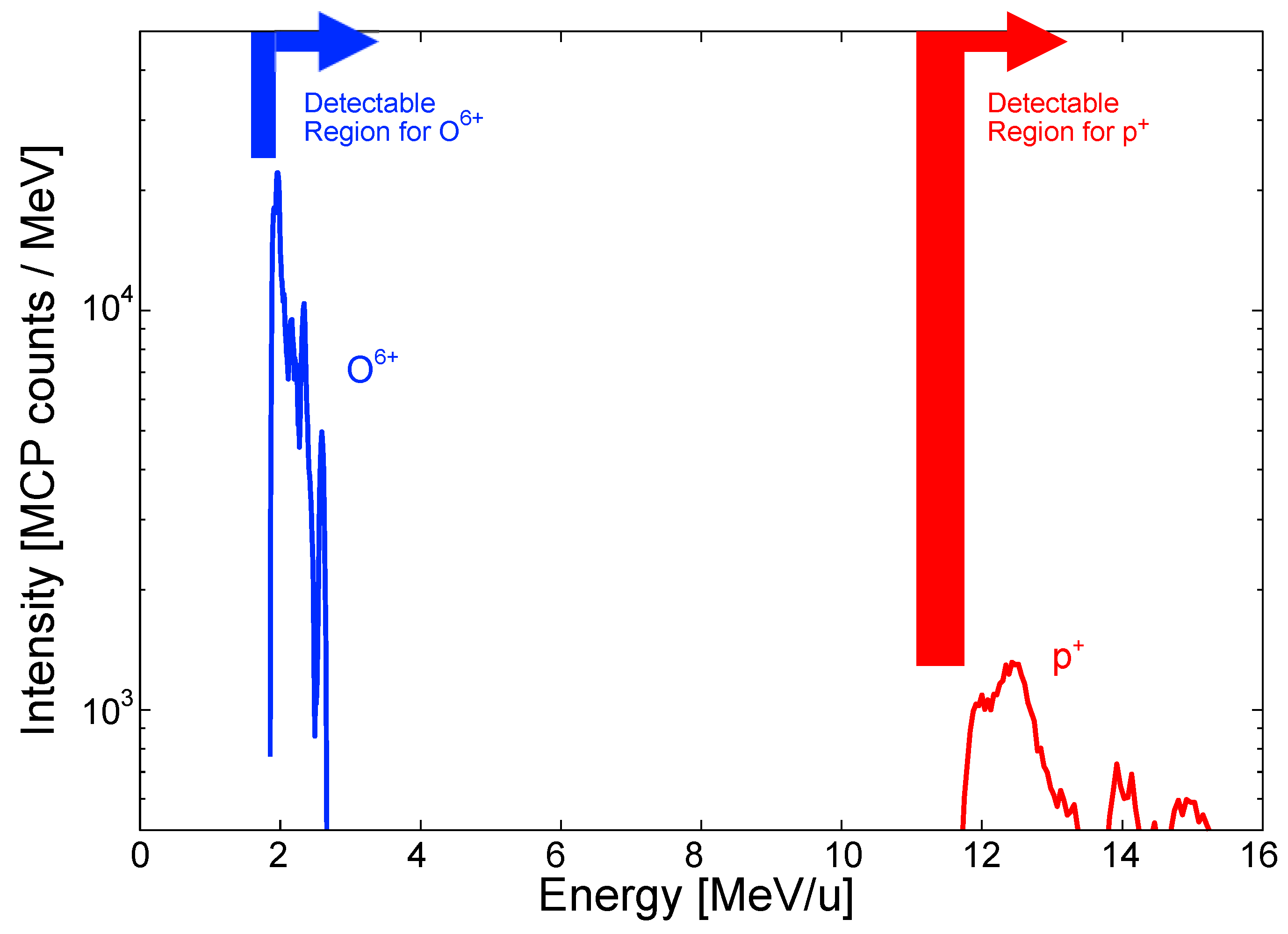
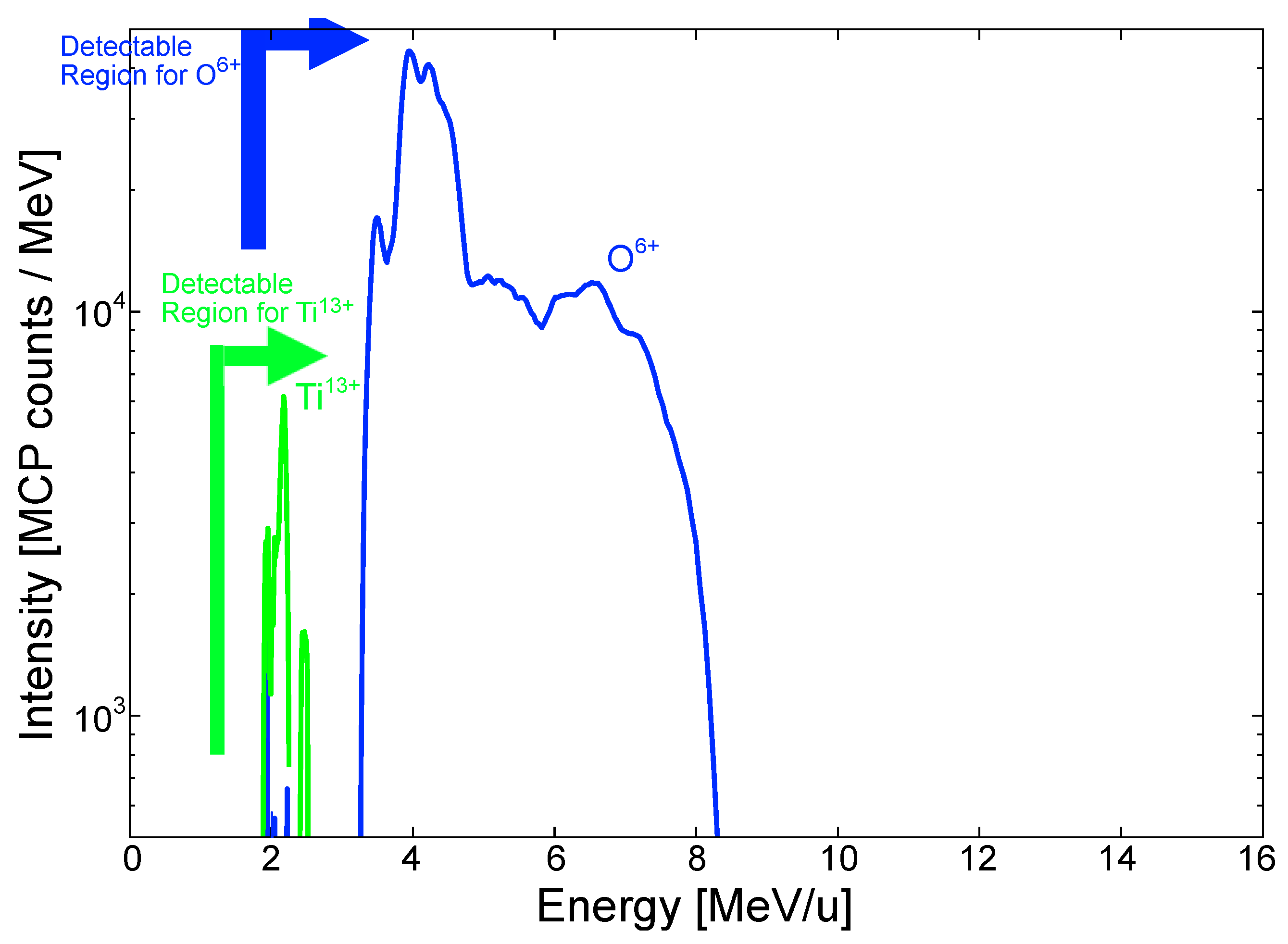
| Ion Species | Q/A | Kinetic Energy [MeV/u] | Φ [MV] |
|---|---|---|---|
| H+ w/o heating | 1/1 | ~20 (Max) | ~20 |
| O6+ w heating | 6/16 | 8.3 ± 0.5 (Max) | 22.1 ± 1.3 |
| O6+ w heating | 6/16 | 3.3 ± 0.1 (Min.) | 8.8 ± 0.3 |
| Ti13+ w heating | 13/48 | 2.5 ± 0.1 (Max) | 9.2 ± 0.4 |
© 2020 by the authors. Licensee MDPI, Basel, Switzerland. This article is an open access article distributed under the terms and conditions of the Creative Commons Attribution (CC BY) license (http://creativecommons.org/licenses/by/4.0/).
Share and Cite
Kondo, K.; Nishiuchi, M.; Sakaki, H.; Dover, N.P.; Lowe, H.F.; Miyahara, T.; Watanabe, Y.; Ziegler, T.; Zeil, K.; Schramm, U.; et al. High-Intensity Laser-Driven Oxygen Source from CW Laser-Heated Titanium Tape Targets. Crystals 2020, 10, 837. https://doi.org/10.3390/cryst10090837
Kondo K, Nishiuchi M, Sakaki H, Dover NP, Lowe HF, Miyahara T, Watanabe Y, Ziegler T, Zeil K, Schramm U, et al. High-Intensity Laser-Driven Oxygen Source from CW Laser-Heated Titanium Tape Targets. Crystals. 2020; 10(9):837. https://doi.org/10.3390/cryst10090837
Chicago/Turabian StyleKondo, Kotaro, Mamiko Nishiuchi, Hironao Sakaki, Nicholas P. Dover, Hazel F. Lowe, Takumi Miyahara, Yukinobu Watanabe, Tim Ziegler, Karl Zeil, Ulrich Schramm, and et al. 2020. "High-Intensity Laser-Driven Oxygen Source from CW Laser-Heated Titanium Tape Targets" Crystals 10, no. 9: 837. https://doi.org/10.3390/cryst10090837
APA StyleKondo, K., Nishiuchi, M., Sakaki, H., Dover, N. P., Lowe, H. F., Miyahara, T., Watanabe, Y., Ziegler, T., Zeil, K., Schramm, U., Ditter, E. J., Hicks, G. S., Ettlinger, O. C., Najmudin, Z., Kiriyama, H., Kando, M., & Kondo, K. (2020). High-Intensity Laser-Driven Oxygen Source from CW Laser-Heated Titanium Tape Targets. Crystals, 10(9), 837. https://doi.org/10.3390/cryst10090837







